How to Raise Chickens: The Beginner’s Guide
by Jennifer Behm – Chicken farmer| Last Updated– 14 February 2021
Keeping chickens in your garden or backyard is becoming increasingly popular. People have seen the benefits of growing their own chemical free vegetables and are now turning to other ways of ensuring that their family has a healthy diet.
There is nothing better than collecting your own organic eggs in the morning from chickens that you know are living a healthy happy life. If you are new to keeping and raising chickens then you will have lots of questions
Aside from simply having the right kinds of equipment, you’ll have to know how to use the equipment and how exactly each device can benefit the lives of your chickens. Caring for chickens can be a time-consuming and difficult process if you’re unaware of what to do, but this guide contains all of the information on how to breed chickens and start a chicken farm at home.
Read on:
- Basic Items Needed to Care for Your Chickens
- Step-by-step instructions
- Сhicken raising – Pro Tips
- Why keep Hens and Chickens?
- How many chickens should you start with?
- What Age of Chicken Should You Start With?
- Why keep a Rooster?
- HOW MUCH DO BACKYARD CHICKENS COST
- Basic Daily Care of Your Backyard Chickens
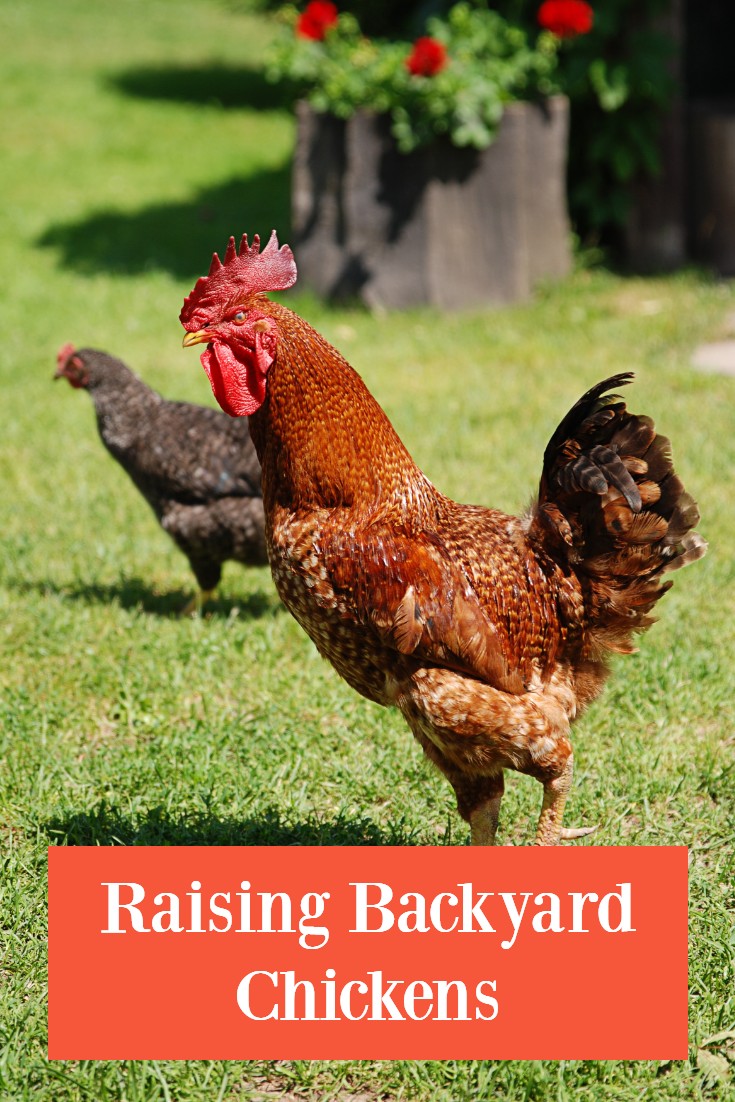
Basic Items Needed to Care for Your Chickens
Once you have chosen your chicken coop, there are four basic items you will always need, to ensure that your chickens stay healthy and produce lots of lovely eggs. These are:
Bedding
Bedding is usually spread on the floor of the chicken coop, to absorb moisture, droppings and odors. A layer of bedding also acts as a soft surface for the chickens’ feet and to keep the birds warm. A good layer of bedding should also be placed in the nesting boxes to provide comfort for the hen when she lays and to protect the eggs.
Wood chips, bark and shavings, chopped straw, and shredded paper all make effective chicken bedding, newspaper or heavily printed paper should be avoided. It is important that the bedding should dry quickly as wet bedding is a breeding ground for parasites, mold, and bacteria, all of which will be harmful to your chicken’s health.
Food
How much food you give your chickens will depend upon how freely they are able to forage. Your chickens can obtain up to 25% of their protein by foraging for grass and insects. You can add (non-meat) kitchen scraps to their diet for variety. Leftovers such as cooked rice and pasta as well as vegetables and fruit can all be given to your hens as treats. Try to avoid citrus fruits or anything that is salty, sugary, or fatty.
Your chickens however should always be fed a complete chicken food of either pellets or meal from a reputable supplier, to keep them in top laying condition. The average chicken will eat between 100-150 grams of complete food a day. So if you start with 3 hens expect to go through a 20 kg bag of pellets every 40 to 45 days, which will cost about $10 per bag. You can also supplement this with around 20 grams of grain a day, but don’t feed this with the chicken feed. The birds will pick the grain out and fill their crops with it and then not have enough room for the more nutritious complete food which is essential for a balanced diet and good egg production.
Read More from prestigequeen.com :
Water
Water is vital for a chicken’s well-being. Eggs are 65% water so your chickens must have access to fresh water at all times. Try to avoid having the water dish where the birds can foul it. A raised water dish or feeder is a good idea and this should be easily accessible at all times. The dish or feeder must be cleaned regularly.
On a hot day, a chicken can drink as much as half a liter of water. In winter make sure that the water does not become frozen, as even in very cold weather the birds will need a constant supply of water.
Grit
As hens do not have teeth they need to ingest grit into their gizzards to help break up their food. If your chickens don’t have access to grit outside you will need to provide them with some.
Step-by-step instructions
Step 1. Choose your chicken breed
First, you’ll want to think about what certain breed of chickens you want to own in your backyard. There are technically hundreds of different breeds of chickens, so you have a large variety to look through. There are four main categories of breeds, including heritage breeds, egg-laying breed, dual-purpose breeds and meat breeds.

Heritage breeds are the most like a pet because they’re natural-breeding chickens. They have a slow growth rate and a productive outdoor life. Not only that, but they tend to live the longest out of all the breeds since they have better well-being and a free-range living environment than the other breeds tend to have.
Egg-laying breed involve chickens that are specifically bred to produce eggs. They have shorter production lives, since hens are capable of laying eggs for a certain period throughout their lives.
Dual-purpose breed are those that offer the most utility. They’re capable of producing eggs for a certain period while also growing at a fast rate so that they can be used for meat purposes.
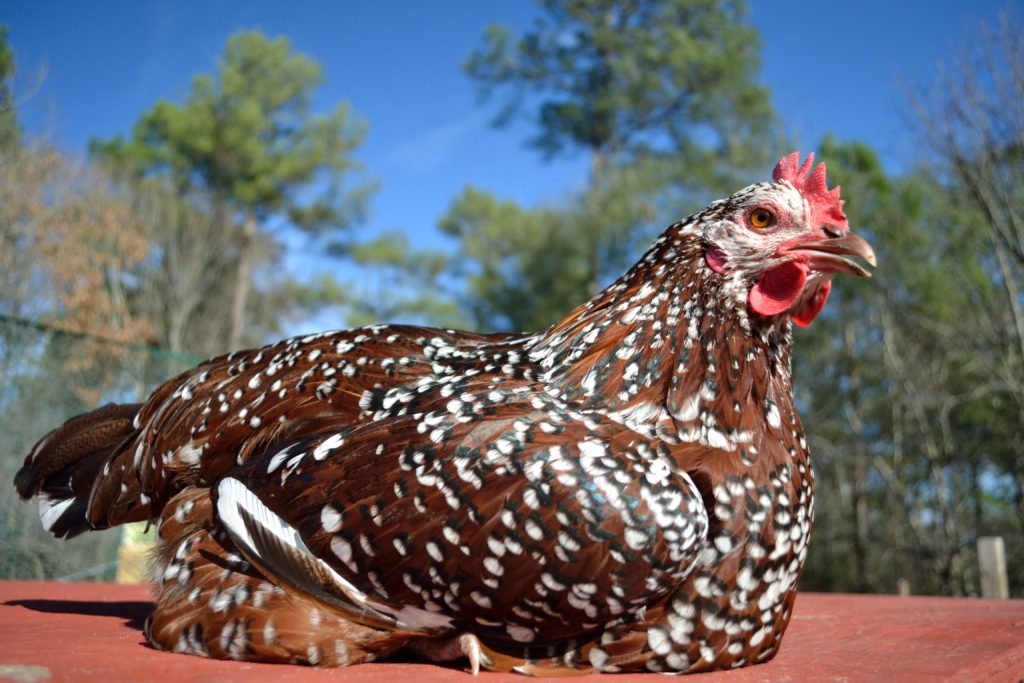
Meat breeds are chickens that grow at the fastest rates. They are bred merely for the meat that their bodies provide. They increase in size at a faster rate than all of the other chickens, and they’re usually ready for slaughter in just nine weeks.
Given each of the different main chicken breeds, you’ll want to consider which type of chicken breed you’ll want the most. For your backyard purposes, you’ll probably want to stick with either heritage breeds or egg-laying breeds, since these are the ones that most suitable for at-home raising.
Step 2. Choose the age of your chickens
The next step to raising chickens for beginners is to choose the ages of chickens that you want to start with. You can purchase them as hatching eggs, chicks, pullets or as adults.
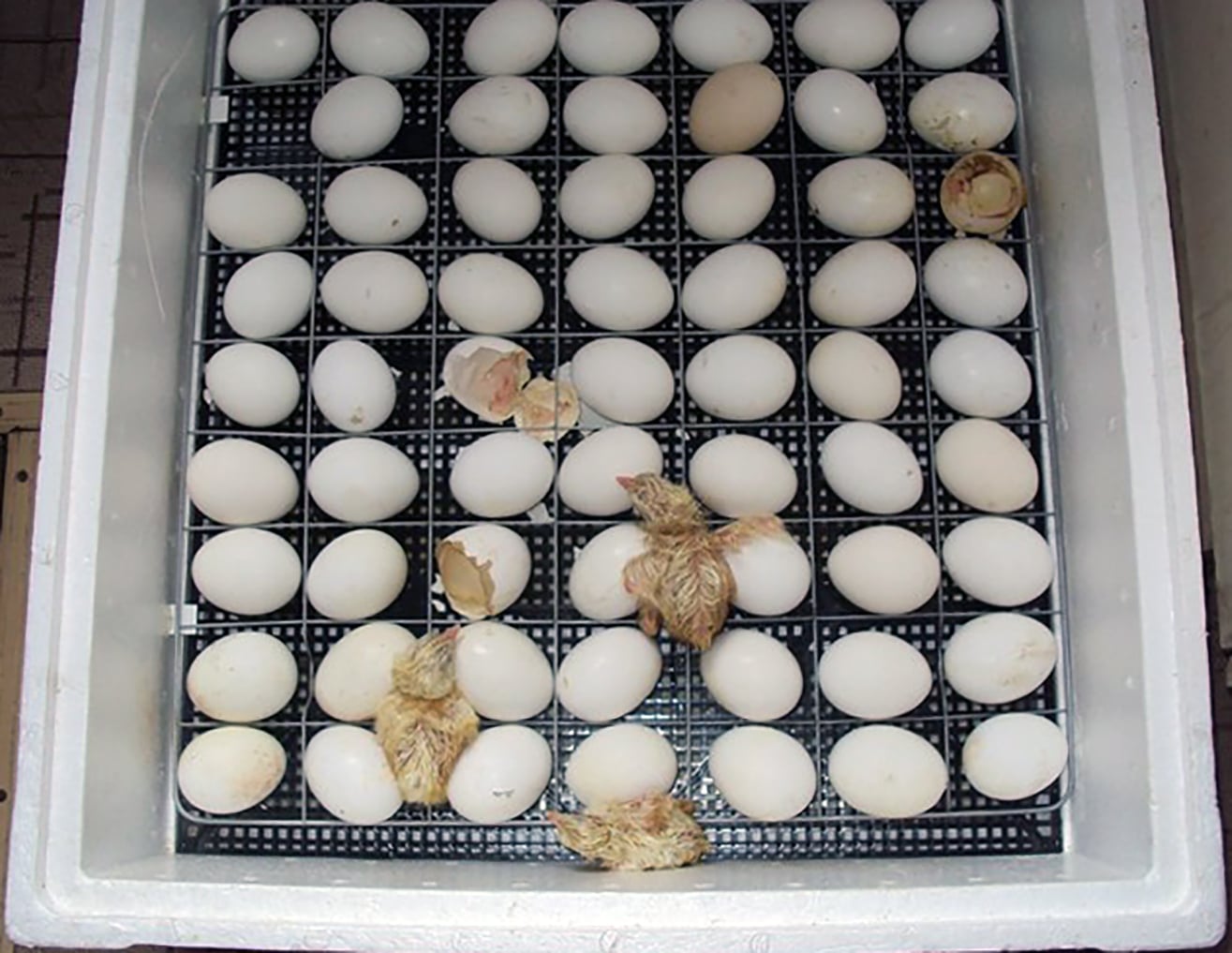
Read More – wtat’s the Best egg incubator ?
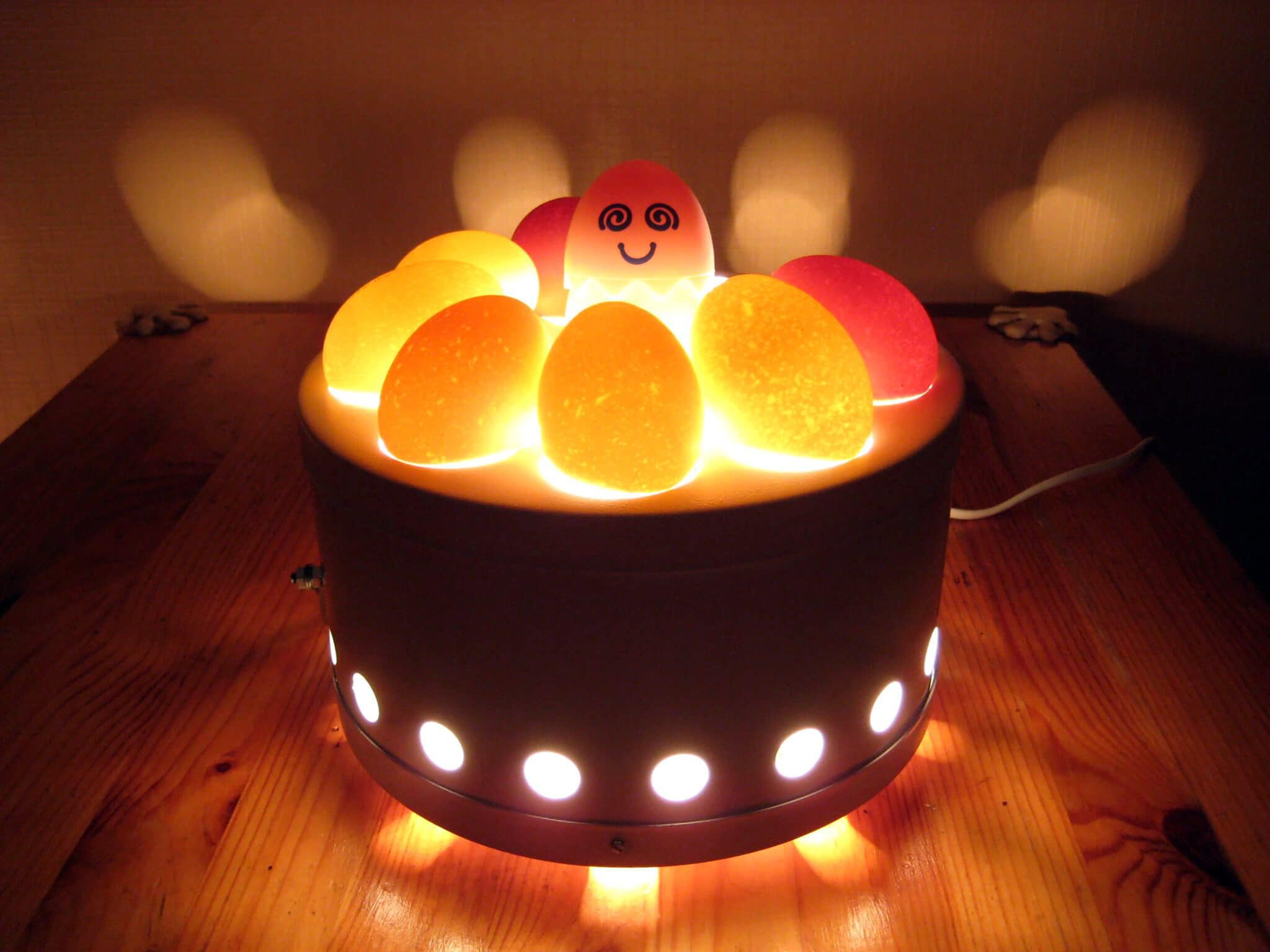
Read More – How to Use an Egg Candler?
Chickens that come as hatching eggs are essentially available as fertilized eggs. They will require the most attention, time and effort, which is why I recommended them more for those of you with more experience. And you’ll also need an incubator for this process, since they’ll need to be cared for without their hens.
Buying chickens as chicks is the more budget-friendly option, since you don’t have to have an incubator or wait as long for them to hatch. In this stage, you’ll probably receive chicks that are one day old, and this is when they’re the easiest to care for. That being said, I most recommend this option as opposed to the others. This is the most common option and is the best for beginners.
Pullets are chicks aged at around four to six months old, and they were reared into adulthood. That being said, you don’t have to worry about having any specific type of feeding method for them. They are essentially sold to you when they’re about to lay their first egg soon.
Lastly, adults are the most difficult to find, and they don’t usually have the longest life with you after purchasing them. You can probably find these at animal shelters or rescue sanctuaries, and I recommend adults to those of you that are simply looking for pet chickens and not productive ones.
Step 3. Decide where to get them from
You’ll then want to think about where to find your chickens and how many you want. The quantity that you want and their location typically depends on the type of chickens that you’re buying and what you’ll be using them for. The quantity also depends on personal preference and how much room you have for them. For instance, if you’re needing chickens for egg-laying, then you may only want a few chickens, unless you’re considering selling the eggs.
As for the location to purchase them, the best place to find chickens as a beginner would be a local farmer or a hatchery. You may also want to consider checking with farm supply stores near you, and you can even check for purchasing them online.
Moving Chicks Outside
our chicks will grow quickly and soon what seemed like a big brood box may start to look cramped, hence our suggestion that you allowed for a minimum of 2 square feet per chick, from the start. If they become cramped they may start picking on each other, even causing injury.
After about two to three weeks depending on the outside temperature (see our guide re temperature) you may consider letting them see the outside world. But never leave them unattended as they will be very good flyers by now and also very easy targets for predators, so keep them confined with netting or chicken wire on top.
Make sure they are out of draughts and have some shade if they need it and plenty of food and water. Young chicks will love the chance to scratch around in the grass and it will also let them use up some of that youthful energy. You should already have ordered the coop for them if these are your first chickens and so it may be that they can be introduced to their future home.
Outside Permanently
By four or five weeks old, again depending upon your climate, your chicks should be ready to go outside permanently. By this time no matter how sweet they still look you will probably be glad to get them out of your home.
Make sure your coop and roosting perch is set up properly and is predator proof and you have all the necessary food and water and then let your chicks move into their new home. It is not a good idea to let young birds out to roam free for a few weeks, but it depends on your set up and how much supervision you can give them and the presence of potential predators.
Introducing Chicks to other Hens
We would not recommend putting new chicks in with existing older ones until they are at least twelve weeks old. Older hens can be brutal to newcomers who cannot stand up for themselves and will easily kill or badly injure a young bird. By twelve weeks they will be strong enough to establish themselves within the flocks pecking order. But you should still keep a close eye on things.
Step 4. Get your chicken coop ready

Read More – Chicken wire fencing Guide
After you’ve found the types of chickens that you want and have a source of obtaining them, you’ll want to make sure that you have the right kind of chicken coop for them. There are different things that you’ll have to consider when finding a chicken coop, including the roof, space, temperature, nesting boxes, roaming pen and the security.
The roof should be both UV-resistant and water-resistant to offer the most long-lasting protection for your chickens. The coop should have enough space so that your chickens aren’t crowded within it. Over-crowding the coop can decrease their overall well-being.
Next, you should have a coop in which you can easily alter the temperature in. For instance, you may want an insulated coop and one that has a source of ventilation. The ventilation can affect the temperature of the coop, directly determining the well-being of your chickens.
Most coops will also come with a nesting box, which can be used for your chickens to lay eggs. That being said, you’ll need a coop that comes with at least one if you’re planning on collecting eggs. Roosts are also important to consider in general, since this is essentially the resting area that all chickens will sleep in. You’ll need this area to be comfortable and protected.
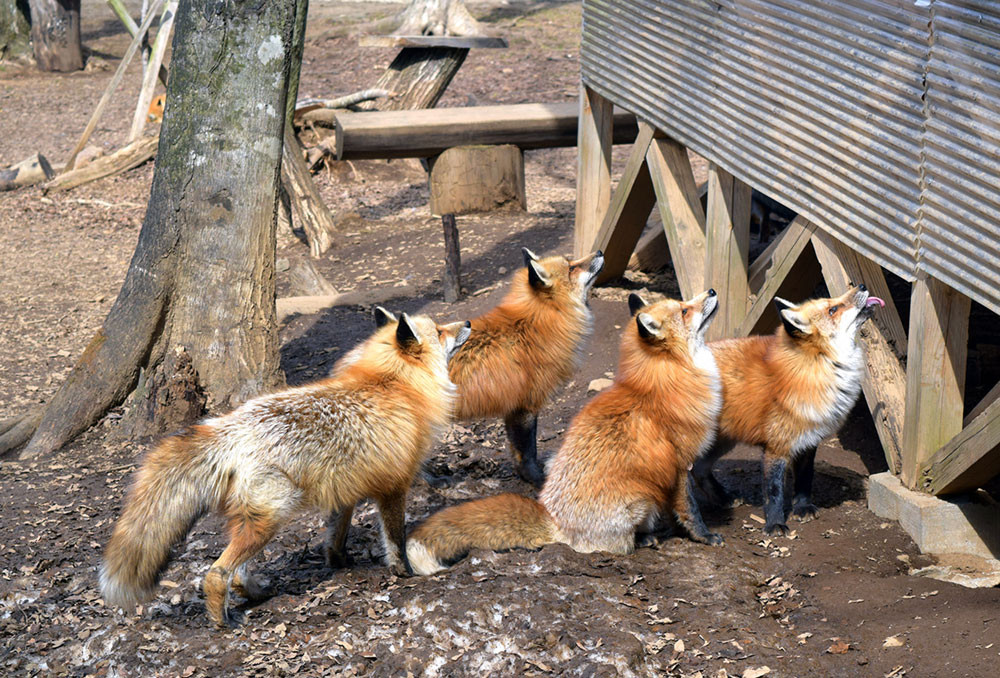
Read More – How to Keep Fox Away from Chickens?
From there, make sure that the chicken coop has some sort of security that keeps your chickens protected. Over night especially, there’s always a risk of predators gaining access into the chicken coop. Strong, durable wire enclosures and metal lathes can help to prevent this from happening.
Lastly, you’ll want to think about the outside roaming pen that’s attached to the chicken coop. You must have a space for your chickens to roam around and stretch their legs to remain in a healthy condition.
Step 5. Purchase equipment and gear for chicken coop
Once you have the chicken coop figured out, you’ll then want to consider what types of equipment you should have inside of the coop to care for your chickens. First, you’ll need a brooder box that can hold your chicks while they’re still extremely young. If your chicken coop doesn’t have one, then you can simply use a large cardboard box.
Pasting Up in Young Poultry Chicks
If your chicks have arrived by mail, before placing them in their brooder you should check them for ‘pasting up’. This is where their droppings harden and block their vents, preventing them passing any further droppings. If not quickly attended to pasting up will kill the chick.
Often pasting up results from stress incurred as a result of the shipping process. But variations in temperature can also cause the problem.
You should check the chicks and also any you have hatched yourself on a daily basis for at least a week. With some young chicks the problem may persist for weeks until they learn to groom themselves properly.
We recommend using a warm wet paper towel to soften the dropping and then with a Q tip or a toothpick carefully clear the blockage and pat the chick dry, before placing it back in the brooder. Vaseline or baby oil can be applied to help move things along.
Be particularly vigilant to chicks who have had a pasting up problem as the condition is likely to return again in the first week to ten days. Always ensure that plenty of fresh clean water is available at all times.
N.B Be very careful that you do not remove any umbilical cord, which may still be attached to the chick’s rear end, this will likely look like a long black string and may be caught up in the hardened droppings. Never pull this as you could cause the chick serious injury.
Read More – The best chicken BROODER
Brooder box
Other than the brooder box, you’ll want to make sure that you have the right bedding inside of the chicken coop. There are many different types of chicken bedding on the market, varying according to the types of material that they’re made of. For instance, since chicken bedding products are made with excelsior while others are made from hemp plant remnants. Regardless, you’ll want a chicken bedding that’s able to absorb the moisture from the chickens’ waste as well as one that’s soft, comfortable, easy to clean and can easily be spread around.
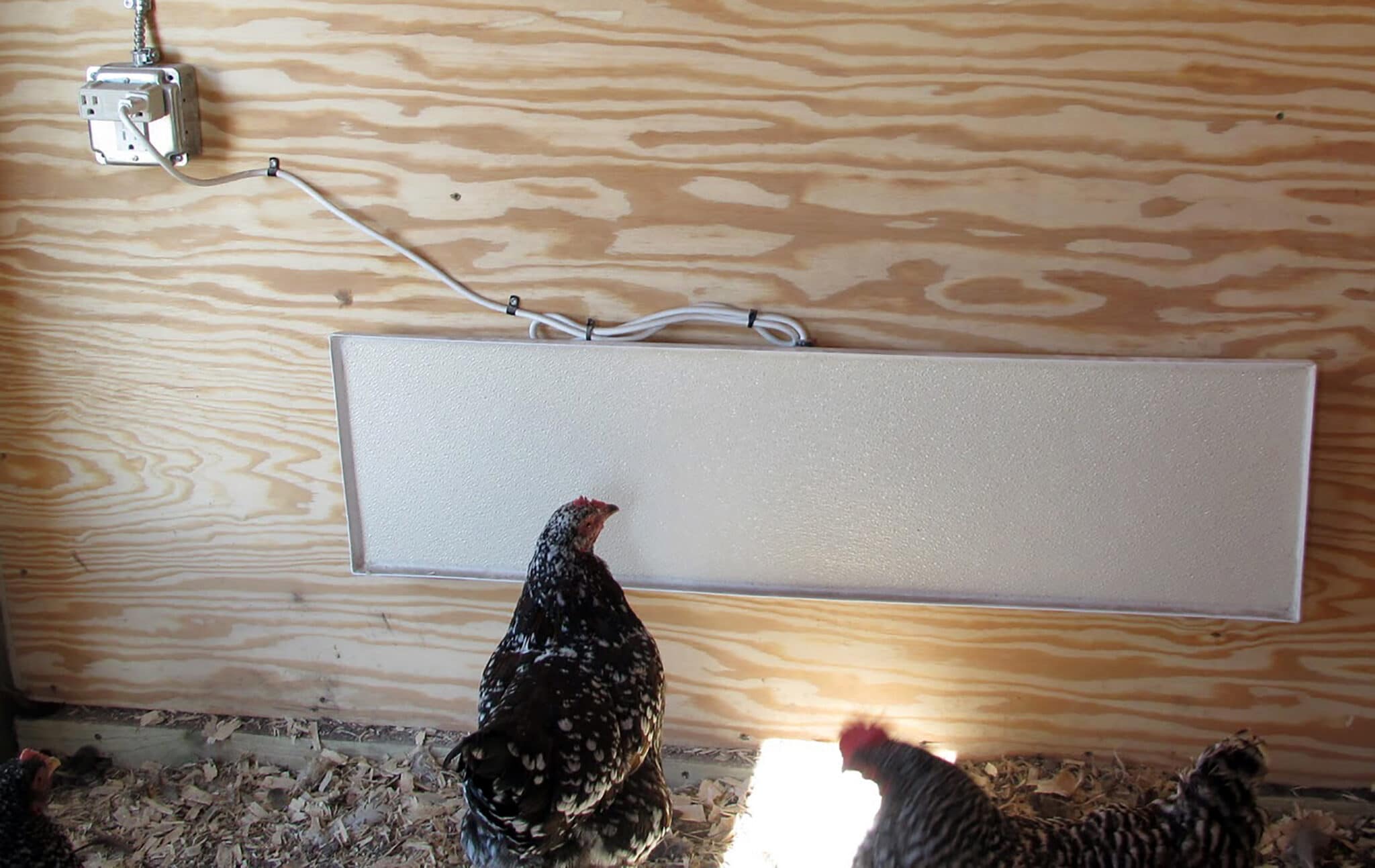
The coop should also be warm, since chicks, in general, don’t have feathers to keep them warm. Most chicks don’t grow true feathers until they’re around six to seven weeks old. That being said, I recommend that you use a heat lamp to provide the warmth that they need. It should essentially be around 95 degrees during their first week with you, and then you’ll want to gradually decrease the temperature by around five degrees as time goes on each week.
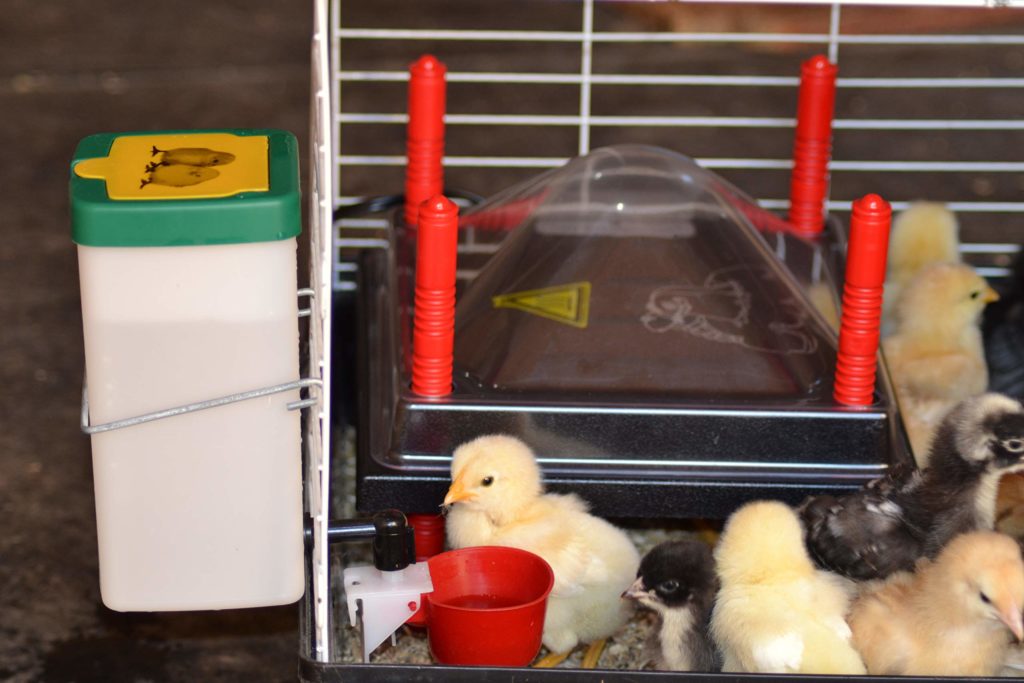
As for the water, your chickens will need water more than they need anything else. The water can be kept in any plastic container within the chicken coop, and it should be kept around room temperature that’s not too hot or cold. When you first place them all together in their cage, you’ll want to dip each of their beaks into the water container to ensure that they know where it is.
Lastly, you’ll want to make sure that you have the right chicken food to give them. There are a variety of different types of foods for each of their different ages, so you must give them food for their specific age.
For instance, for chicks that are under eight weeks old, they’ll need crumbles of starter feed. For between eight and 14 weeks, they’ll need a mixture of starter feed and grower. For those between 15 and 18 weeks, they’ll need finisher feed, and those beyond 18 weeks can simply have layer feed.
You’ll want to consider whether you’re going to give them chicken food that’s been medicated or not. Coccidiosis is one of the most common and deadly diseases for chickens and some feed comes medicated from this disease. That being said, I recommend that you use medicated chicken food if your chickens haven’t been vaccinated.
Step 6. Cleaning the coop
You’ll want to make sure that you become familiar with cleaning the coop, since you want the chickens to have a safe and healthy environment. To clean, you should be removing the waste daily, and there’s usually a pull-out waste tray for that. Other than that, you’ll want to shovel out and replace the dirty feed every time it gets wet, which can be anywhere from a few days to a week or two. For more assistance, here is a YouTube video on how to clean the chicken coop.
Read More – Nest boxes: nesting area for chickens
Step 7. Routinely care for them
After you’ve situated all of your chickens into their cage, there are a few things that you should be doing routinely to keep up. You should be giving them fresh water a few times a day since hens require up to a cup of water a day. And you should be giving them fresh food every day. In the morning, you’ll want to let the chickens out of the roosts to roam. And in the nighttime, you’ll want to lock them back up and collect the eggs.
Read More – Rat Proof Feeder for chickens
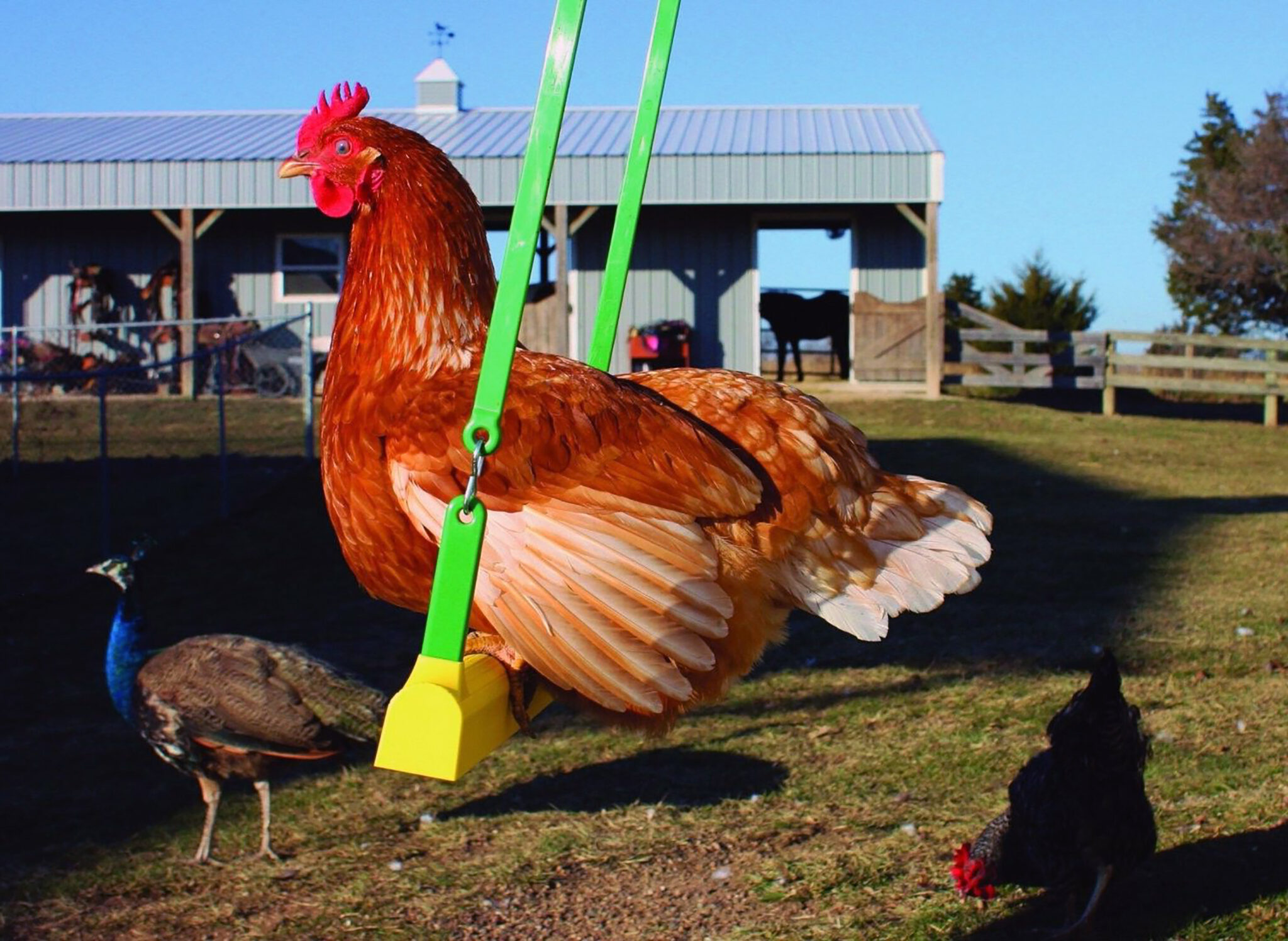
Read More – The Best Toys for Chickens
Сhicken raising – Pro Tips:
- Learn about the regulations for having chickens in your area
- Research the different types of breeds that are best for the conditions you’ll provide (some do better in warmer or cooler environments)
- After the chicks are in the brooder box for 8 weeks, place them into the chicken coop that should given them 3-5 square ft of floor space
- Train your other pets to behave around the chickens before leaving them roam together (expose your dogs and cats to the chicks, while supervised)
- Most chickens can lay eggs for up to 4 years, but they can remain alive for years after that (think about what you’re going to do with them afterwards)
Why keep Hens and Chickens?
There are many reasons to keep chickens and a few reasons not to. If you are reading this it is likely that you have an interest in eating and living in a more natural way. The last few years have made us all reflect on what is really important in life and making the most of our homes and family has again become a top priority.
As people eat out less and increasingly look for ways to add to the family budget, growing your own food, has become more and more popular. As a result people who have successfully grown their own vegetables are now also looking to keep chickens.
So what are the benefits of keeping hens and even raising your own chickens?
The primary reason of course is to produce your own organic eggs and if you wish your own organic meat. The great thing about eating your own eggs or chickens is that you know exactly what has gone into them. You can be happy in the knowledge that they have been fed a healthy diet, free of any nasty unknowns.
You also know that your produce is healthier for the environment as there has been no gas guzzling miles involved in transporting it to your kitchen. Your chickens can also be fed on your non-meat kitchen scraps which is a great way of recycling organically.
You can also eat your eggs at breakfast, free from guilt at the thought that the hen that laid them may have suffered a miserable factory-line life in some crowded shed.
You will never have to buy a bag of fertiliser again as chicken droppings make a superb garden fertiliser, being rich in potassium, nitrogen and phosphorous. If you can’t use it all, local gardeners and allotment owners will be delighted to have it instead and may even be willing to pay you for it.
Keeping chickens will provide hours of entertainment and your kids will love having them around. They make excellent pets and are far more interesting than guinea pigs or hamsters and are able to lead a better life than the poor imprisoned family rabbit. You will be surprised at how different each chicken’s personality will be and how relaxing it is just watching them pecking around the backyard.
You may also find that you become so proud of your chickens that you decide to enter them into shows. A whole new world of prizes and glory can be yours. You could also decide to breed and sell this prize-winning line of birds you now have.
So there are lots of good reasons for keeping your own chickens. As long as you have permission to keep them on your land and you have the time to look after them then there is nothing to stop you.
How many chickens should you start with?
One of the first things people ask when they are thinking of keeping chickens is, how many birds should they start with? If you have never kept chickens before and you are planning on keeping them in your backyard then I would suggest two or three is a good place to start. Chickens are sociable creatures so it is considered unkind to keep just one solitary bird.
If you are intending to keep chickens primarily to provide eggs for your family then of course it depends on how large your family is and how many eggs you need a week. In general three birds will provide enough eggs for the average egg eating family of four.
A hen will lay one egg a day, assuming it is well fed, healthy and has plenty of water. Egg laying is determined by the amount of daylight hours so she will reduce her egg laying as the days shorten and may even stop altogether over winter, if she becomes too cold. During her lifetime a hen can lay up to thirty times her own body weight in eggs. If the eggs are not collected she will stop laying after she has three or four and sit on them to try to hatch them, which as they will be unfertilized (without a rooster) will not happen.
The type of breed will also determine how many eggs are laid per year. For example, a Light Sussex may lay up to 220 eggs a year, while a show breed such as the Orpington may only produce 80 eggs a year. So it depends what is more important eggs, or show stopping chickens.
Hybrids (a combination of breeds) are bred for either meat or egg production and the latter such as ‘Bovan Goldline’ (the type of hens used in most battery farms) can lay up to 320 eggs per year. However not all strains of the same breed will lay the text-book number of eggs since there has been a large amount of selection for specific traits desirable on the show circuit and sometimes egg production has actually been bred out of these birds.
As a chicken ages she will also start laying fewer eggs. She will start laying eggs at four to five months and most hit peak production in their first and second years of laying, with the quantities decreasing by around 10% per year after this.
There is no need to keep a male chicken (rooster) to get eggs, all the eggs we eat are unfertilized and you will only need a rooster if you plan on rearing your own chickens.
What Age of Chicken Should You Start With?
If you have decided to keep some chickens in your backyard or garden you will have to decide what age of chicken or hen to start with. You basically have three options, each has its advantages and disadvantages:
Day old chicks
Baby chicks are adorable and usually cost just a few dollars each. Starting with chicks is very rewarding as you can watch them through all their growth phases and you can tame them fairly easily if you handle them correctly from a young age. Another fun thing about day old chicks is that you can order mixed-breed lots and watch a variety of colours and feather characteristics develop.
However baby chicks are extremely delicate and even experienced poultry raisers lose a percentage of their stock. Older birds have a much higher survival rate. Chicks are very susceptible to a number of health conditions, variations in temperature and are easy prey for anything, including cats.
Starting with day old chicks also requires setting up a brooding area that needs to be carefully maintained, whereas older birds are a bit more independent. If fresh eggs are your ultimate goal, then it will be four to five months before they will start laying.
It’s also hard to determine the gender of a newly hatched chick (even for professionals). If you are raising chickens in the city and are not allowed to have roosters, or you don’t wish to keep a rooster, you may get a male in the bunch and therefore you will need to have a Plan B for when he grows up.
Pullets
A pullet is a female chicken that has not yet begun to lay eggs (usually from 4-20 weeks old) and a cockerel is its male counterpart. If your only goal with chickens is eggs, you don’t need any male birds.
Pullets are bigger and stronger than chicks, but are still young enough to be easily tamed. They handle the stress of moving well and have usually developed some resistance to coccidiosis and other poultry problems.
They are also closer to maturity, so you won’t have to wait as long to start getting eggs. At this age, it’s usually pretty easy to distinguish the pullets from the cockerels so you probably won’t get any surprises with most breeds. With some breeds it’s not so easy.
However birds of this age are a few dollars more than chicks. If you order pullets from a hatchery or breeder, they are much more complicated and expensive to ship. You will probably need to buy them in person and it’s not always possible to locate a seller with birds of the right age available exactly when you want them.
Laying Hens and Adult Birds
With fully grown birds, all the hard work has been done and hens will either be laying already or close to it and their personalities will be developed. Also by this age there will be no surprises with respect to gender, as it is pretty clear by this stage which are males and which are females.
If you plan on showing or breeding poultry, there is no guessing about how a bird will turn out and you will be able to see its specific characteristics. It is also possible to get adult birds cheap or even free from a breeder, as people who show chickens will sometimes give away birds that don’t win consistently. They may not be show winners, but make perfectly wonderful pets and egg layers.
Fully grown chickens are also very good at defending themselves against cats (though not against dogs or other predators).
However fully grown chickens are the most expensive, because the person who raised them has already put significant time and expense into feeding and raising them. They are expensive to ship if you need to order by mail, and don’t travel as well as day-old chicks.
So you will have to decide how much time you want to put into getting your birds started and where you are going to get them from.
Why keep a Rooster?
For starters, roosters are male chickens and if you want your chickens to give birth to beautiful tiny little baby chickens and keep your chicken farm growing, you will need a few roosters in your chicken farm. Though roosters are capable of driving hens crazy at times, the only way you are going to get fertile eggs for a hen to nest on is to have a rooster in the pack. And boy will you be in for a treat when that rooster gets turned on by a hen. Roosters tend to do a little vaudeville esque dance when they become attracted to a female chicken. He will skitter sideways and open his wing faethers downward sort of like an oriental fan. It is really a treat to watch or capture on film if you are so lucky.
Another reason why keeping a rooster in your chicken flock is a wise idea is for the protection of your chickens. It is a rooster’s instinct to protect its hens from harmful predators that may invade the chicken pen and threaten your livestock. A rooster will protect his flock the instance he thinks that one of its members is being harmed. Also, when one of his hens is nesting on their eggs, the rooster will be on full alert and protect her and the eggs from nearby predators. This goes for us humans too. It best not to let a rooster see you disturbing the hen or he will attack you.
The Rooster Pecking Order
The nature of the rooster is quite amazing and if you really sit down and observe them, you will be greatly entertained. You see, when a new rooster is introduced to the flock, he is not accepted with the highest regard from the other roosters. As a matter of fact, there will be a fight amongst all the roosters, especially the new one to determine who is boss and what the ranking order, or in this case, the pecking order is established. The pecking order works this way: The king of the flock is known as the Alpha Male and he is first in all matters whether it be fighting intruders, leading the pack around the chicken run, and even first liberties with new hens or pretty much any hen he wants from the flock. No rooster will dare challenge him once he has been established as first in the pecking order for he will receive a great pecking reminder. So how does the Alpha Male keep his throne? Well, by simply reminding his subordinates with a good old beating, or by interfering when another rooster is trying to mate with a hen. When this happens, the Alpha male will push aside the other rooster with either a hard beating or his presence alone will cause the rooster to yield. The Alpha male will continue to be king until he is either de-thrown by a new rooster or becomes too old to lead the pack in which the Beta Male, or second in command, will take over.
Basic Daily Care of Your Backyard Chickens
Chickens are relatively undemanding pets, with fairly basic needs and this is one of the reasons why chicken keeping is so popular. However there are some simple tasks that do need to be carried out daily to ensure that you keep a clean and healthy chicken coop, but these should only take a few minutes a day.
Ideally you should let your chickens out in the morning. Then make sure that their feeding and drinking utensils are clean and in good condition and that they are filled with clean food and water. Chickens will eat most of their food in the morning and also lay their eggs then. They usually come out to eat and scratch about a bit and then return to their nesting area to lay an egg. If possible you should collect any eggs that have been laid, storing them with the blunt end up in a cool place or have them fresh for breakfast.
Always watch your chickens for a few minutes to ensure that they look active and healthy and that they are feeding normally. Check your chicken coop for any signs of damage or disturbance from predators. If any repairs are necessary do them immediately as most predators wont give up until they have got inside and are therefore likely to quickly return.
At dusk your chickens will normally return to their house to roost of their own accord. Always lock the coop at night with your chickens safely inside, never be tempted to leave the coop open at night as even in urban settings there are plenty of predators, such as foxes, on the prowl who will be only too glad to have a chicken dinner. If you think that you are not going to be able to always do this, you should consider an automatic closer on the chicken coop door. You should also check that your chickens have fresh water and food for the night and remove any wet bedding if possible.
Your chicken coop should be cleaned once a week, or twice a month if you only have a few hens. However, you should always be vigilant daily about damp bedding, which might indicate a leak in the coop roof, remove it and replace it with dry bedding as soon as possible as dampness can quickly lead to respiratory and other problems in chickens.
If you have to go away for a few days then it is possible to leave your chickens as long as they are in a secure coop and have an adequate supply of water and food. There are many good automatic feeders on the market which you can use. If you plan on being away for longer then you must arrange for someone to come in and look after your chickens.
Obviously daily care will change slightly depending upon the weather. In summer your chickens will need more water and also some shade to allow them to escape from the sun.
In winter depending upon how cold it gets, you may need to provide extra insulation to the coop. Also chickens will still need to drink a lot of water, so it is important that this does not freeze and you may even need to consider a warmer under the water dish if you are not able to check regularly for freezing throughout the day. Chickens are also prone to frostbite on their combs and wattles. This can be prevented by applying petroleum jelly to the areas every couple of days.
Establish a good daily routine from the start and your chickens will be happy and healthy.
Read More from prestigequeen.com : Best Chicken Plucker Machine for Meat-producing chickens
Conclusion
Overall, raising your chickens in your backyard can seem like a time-consuming and tedious task, but the effort put in has large rewards. It only takes getting into a routine, and then you’ll feel comfortable in your chicken-farming process. Not only will you have a constant supply of eggs for your household, but you may also be able to sell some of the eggs that you collect as well.
Even more, you’ll have pets that you can care for and provide a great home to, increasing the overall quantity of their lives. This complete guide can make it extremely easy to care for your chickens at home, and I hope you found it helpful and enjoyable to read in finding out how to breed chickens. If so, you’re more than welcome to comment your thoughts and opinions about this guide, and you can even share it to allow others to benefit from the read as well.
Read More from prestigequeen.com :
- Books on raising chickens
- Can ducks and chickens live together?
- HOW MUCH DO BACKYARD CHICKENS COST
- What are the 10 reasons that we want to homestead?
- Chicken Illnesses, Disease and Injuries
- Anatomy – egg-laying chickens
Contents
